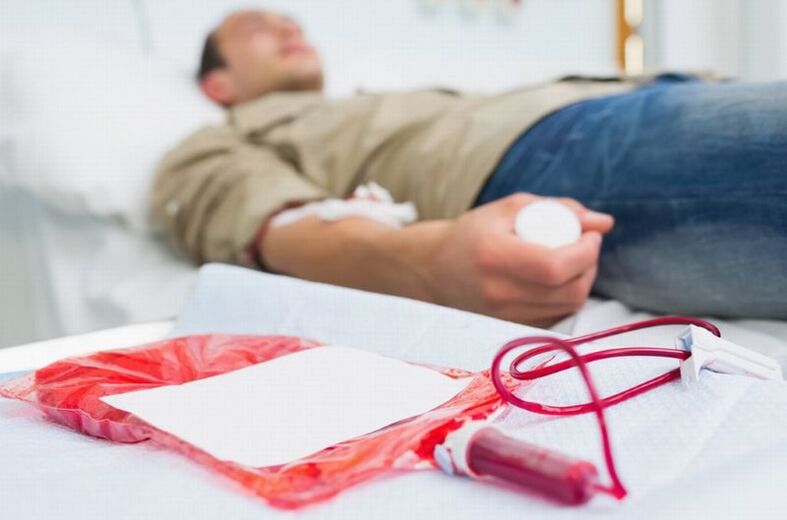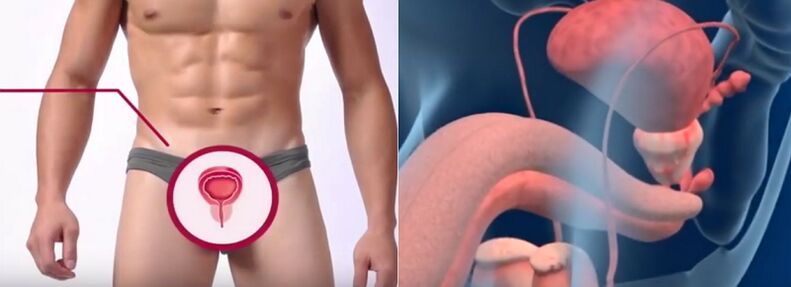By prostatitis, urologists understand inflammatory processes in the prostate that occur for various reasons. The prostate belongs to the genitourinary system, surrounded by other organs and tissues, therefore the symptoms, especially in the initial stages, do not allow to determine the disease. Let's try to figure out what the first signs of prostatitis can indicate the onset of the disease and tell you where to turn for help.
Signs of chronic abacterial prostatitis
The disease occurs due to trauma to the tissues of the prostate or due to the influence of a number of other factors:
- sedentary lifestyle and accompanying disorders of blood microcirculation;
- reflux of urine into the prostate;
- narrowing of the lumen of the urethra due to a tumor, stone, or inflammation;
- sharp contraction of the pelvic muscles;
- Hypothermia, smoking, alcohol abuse.
Symptoms of this form appear gradually, their severity increases over time. Initially, men may complain of a frequent urge to urinate, accompanied by a burning sensation in the urethral opening.
At this stage, prostatitis can be confused with urethritis, so laboratory diagnostics is important.
As the inflammatory process progresses, other signs of the disease appear in the tissue of the prostate:
- urge to urinate at night;
- pain in the perineum (may radiate to the glans, anus, thighs and lower abdomen);
- absent or weak erection;
- pain during ejaculation;
- Increase in body temperature to 37. 5-37. 8 ° C.
With violation of the integrity of the tissues of the prostate or adjacent areas of the urethra, blood in the urine or semen can be observed. The male pays attention to small flakes of scarlet or brown color.
Signs of acute bacterial prostatitis
Bacterial prostatitis is caused by pathogenic and conditionally pathogenic microflora. Microorganisms can live in the intestines or on the skin of a man if the rules of hygiene are not observed, get into the prostate through the urethra and quickly develop in the tissues of the gland. Another possibility is penetration of the pathogen into the urethra and then into the prostate during unprotected sex. Infection is also possible with an incorrect prostate biopsy.
Once on the mucous membrane of the prostate, bacteria develop rapidly, the colony grows in just 2-3 days. The first signs of prostatitis in this case are:
- chills, fever, fever;
- pain in the perineum, lower back, or lower abdomen;
- Violation of urination (pain, intermittent stream of urine, frequent urges).
Without treatment or improper therapeutic tactics, the disease will progress. After a few days, constipation, acute urinary retention, muscle, joint and lymph node pain can occur. Symptoms of intoxication are also possible - nausea, vomiting, weakness.
The interval between the first symptoms and the most noticeable clinical picture can be 3-4 days.
Signs of chronic bacterial prostatitis
The chronic form of bacterial prostatitis occurs with improper treatment of an acute course, as well as due to trauma to the bladder and illiterate catheterization. It is not excluded that the inflammatory process in neighboring organs passes to the prostate.
A man may miss the first signs of chronic prostatitis - the symptoms of this form are characterized by mild severity, periods of remission are possible. You can suspect the disease by the following manifestations:
- problems urinating;
- dull, aching pain in perineum;
- erection problems.
Phases of exacerbation alternate with rest. A man can mistakenly think of healing and not see a doctor. Such an attitude is dangerous - the inflammatory process progresses, prostate tissue is reborn, and the organ loses its functions. As a result, prostatitis can lead to infertility and cause sepsis - blood poisoning.

Clinical manifestations of pathology
Prostatitis has no characteristic signs, it can be confused with other diseases that have similar symptoms - with cystitis, urethritis, chlamydia.
Knowing the first signs of the disease does not help to make an accurate diagnosis. It is more effective to pay attention to clinical manifestations.
With acute bacterial prostatitis, the following signs are characteristic, which are detected during examination and laboratory tests of urine and blood:
- body temperature in the anus is 0. 5 ° C higher than the temperature in the armpits;
- increase in the number of leukocytes in the urine;
- decrease in the number of eosinophils;
- increase in C-reactive protein;
- increased levels of PSA in the blood.
A blood test for PSA levels is not mandatory, but helps to get a clearer picture of the pathological course.
How to provide first aid and who to contact for treatment
Prostatitis refers to diseases that do not threaten the patient's life in the initial stages. With severe pain, you can take painkillers, but this is an exception to the rule. It is better not to drink such pills so as not to blur the clinical picture and prevent the doctor from making a correct diagnosis. Antipyretics can be taken for high fever.
With a competent approach, first aid is provided in a medical institution. To do this, a man needs to contact a urologist at the place of residence or stay. If for some reason it is not possible to see a doctor yourself, you need to call an ambulance.
It is strictly forbidden to take antibiotics yourself.
These drugs are prescribed taking into account the type of pathogen, uncontrolled intake can increase the resistance of bacteria and aggravate the manifestation of poisoning.
Consequences of ignoring the first signs
Most men prefer not to see a doctor, especially when it comes to problems in the genitourinary system. This attitude can be dangerous. Prostatitis is a serious disease and can have negative consequences:
- Transition to a chronic form that is practically untreatable;
- development of infertility;
- Spread of infection to neighboring organs;
- decrease in potency;
- Occurrence of sepsis.
The latter condition directly threatens the patient's life. The probability of a fatal outcome is 30-50%, and every hour delay in medical care increases this figure by 8%.

Summarize
Knowing the first signs of prostatitis in men will help to suspect problems in the body. A more accurate diagnosis is made on the basis of an instrumental examination and the results of a laboratory test of blood and urine. Prostatitis can threaten a man's life, so self-treatment is unacceptable. If you postpone going to the doctor, the disease can become chronic, which is very difficult to cope with.

















